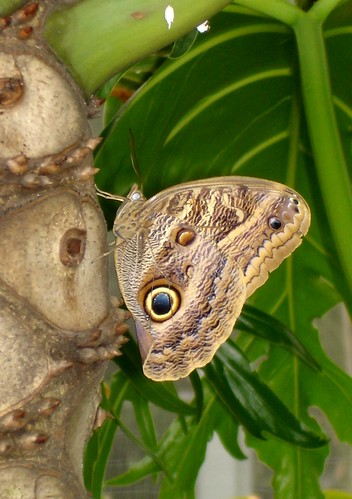
Borboleta, originalmente cargada por BetoDiniz.
A butterfly is an insect of the order Lepidoptera. Like all Lepidoptera, butterflies are notable for their unusual life cycle with a larval caterpillar stage, an inactive pupal stage, and a spectacular metamorphosis into a familiar and colourful winged adult form. Most species are day-flying so they regularly attract attention. The diverse patterns formed by their brightly coloured wings and their erratic yet graceful flight have made butterfly watching a hobby.
Butterflies comprise the true butterflies (superfamily Papilionoidea), the skippers (superfamily Hesperioidea) and the moth-butterflies (superfamily Hedyloidea). Butterflies exhibit polymorphism, mimicry and aposematism. Some migrate over long distances. Some butterflies have evolved symbiotic and parasitic relationships with social insects such as ants. Butterflies are important economically as agents of pollination. In addition, a few species are pests, because they can damage domestic crops and trees in their larval stage.
Culturally, butterflies are a popular motif in the visual and literary arts.
Wing developmentWings or wing pads are not visible on the outside of the larva, but when larvae are dissected, tiny developing wing disks can be found on the second and third thoracic segments, in place of the spiracles that are apparent on abdominal segments. Wing disks develop in association with a trachea that runs along the base of the wing, and are surrounded by a thin peripodial membrane, which is linked to the outer epidermis of the larva by a tiny duct.
Wing disks are very small until the last larval instar, when they increase dramatically in size, are invaded by branching tracheae from the wing base that precede the formation of the wing veins, and begin to develop patterns associated with several landmarks of the wing.
Near pupation, the wings are forced outside the epidermis under pressure from the hemolymph, and although they are initially quite flexible and fragile, by the time the pupa breaks free of the larval cuticle they have adhered tightly to the outer cuticle of the pupa (in obtect pupae). Within hours, the wings form a cuticle so hard and well-joined to the body that pupae can be picked up and handled without damage to the wings.
Scales
Butterflies are characterized by their scale-covered wings. The coloration of butterfly wings is created by minute scales. These scales are pigmented with melanins that give them blacks and browns, but blues, greens, reds and iridescence are usually created not by pigments but the microstructure of the scales. This structural coloration is the result of coherent scattering of light by the photonic crystal nature of the scales. The scales cling somewhat loosely to the wing and come off easily without harming the butterfly.
| Closeup of the scales of the Inachis io |

















No hay comentarios:
Publicar un comentario